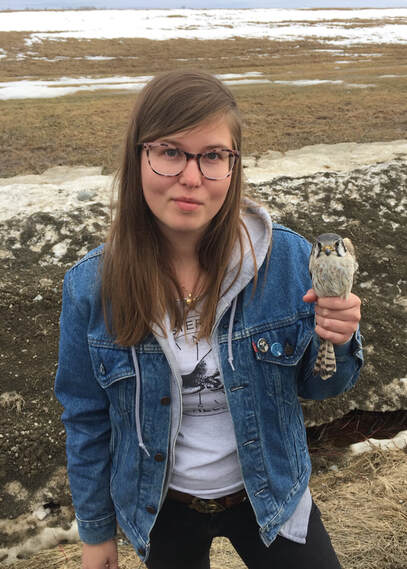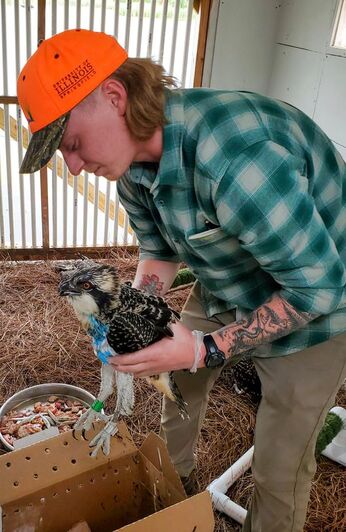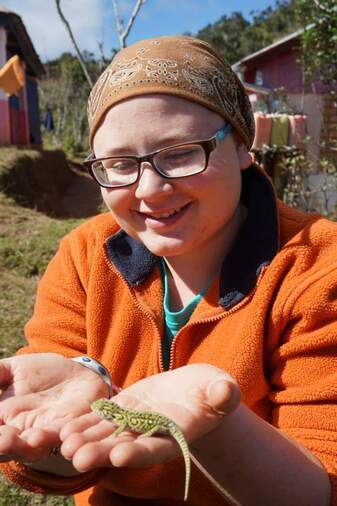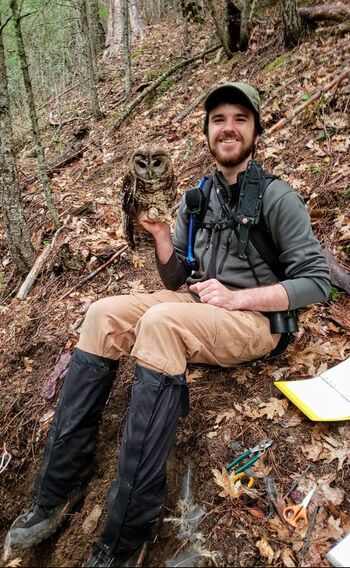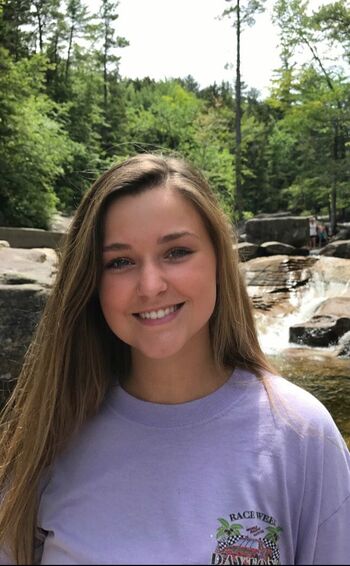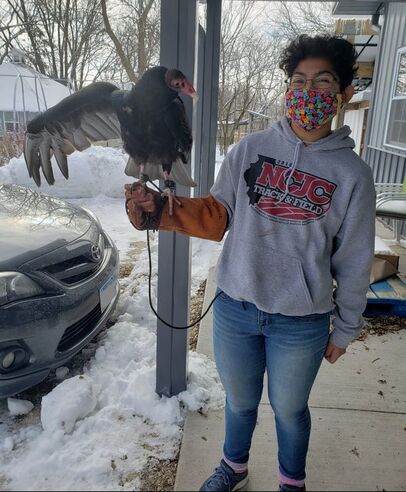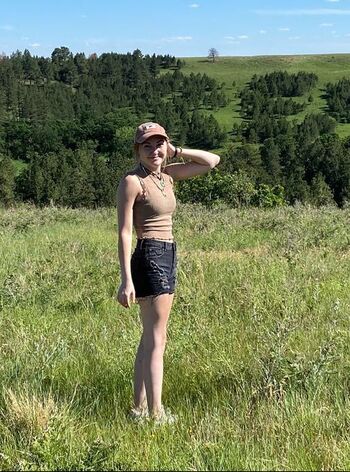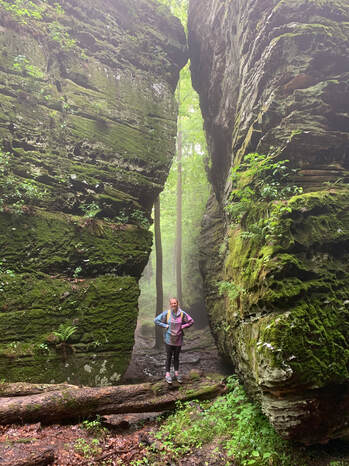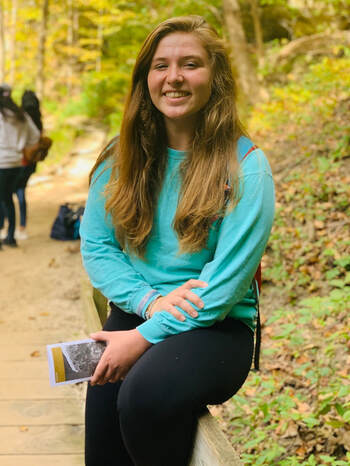|
Frances Whalen
M.S. Graduate in Environmental Science
Frances has a B.S. in Biology from Western Michigan University. Since obtaining her bachelor’s degree, she has worked a variety of avian-related field jobs throughout the Midwest and Canada at banding stations, nonprofit organizations, and universities. The majority of her work has been focused on collecting data about migrating raptors, however, most recently she worked as a fisheries technician for Southern Illinois University. She has a GPSI position at the Illinois Department of Natural Resources as an Environmental Impact Assessment Intern. While at UIS, her research will increase our current understanding of the overwintering ecology of American Kestrels in Illinois.
|
|
Andrew Stokes
M.S. Graduate in Environmental Science
As an undergraduate at Oregon State University, Andrew participated in several internships in which he performed point counts in the Willamette Valley to examine the effects of supplemental feeding on Black-capped Chickadees (Poecile atricapillus), identified species richness and abundance of tropical hummingbirds from trail camera footage obtained in Costa Rica, and dissected the stomach contents of lethally removed Barred Owls (Strix varia) to investigate trophic cascades associated with the species' recent range expansions. Since graduating with a B.S. in Wildlife Sciences in 2018, Andrew has conducted field surveys on a variety of songbird and raptor species for OSU's Department of Forestry and the U.S. Forest Service throughout Oregon, Washington, and California. He recently collaborated on a project examining the relationship between the sex-specific microhabitat uses and sex-biased thermal physiology of Anolis lizards in the Bahamas and Panama, which was published in the Journal of Experimental Biology (see Logan et al. 2021). For his Master’s thesis, Andrew is modeling the population dynamics of two translocated Osprey populations in central Illinois. His research will be used to predict the number of juvenile Ospreys that must be translocated to achieve self-sustaining populations in the state, and to identify salient management strategies that will have the greatest influence on the long-term viability of the populations. Andrew’s primary research interests include population modeling, threatened and endangered species conservation, evolutionary biology, and biodiversity preservation.
|
|
Laura Hardy
M.S. Graduate in Environmental Science and Management
Laura has her BS in Environmental Studies with an emphasis in non-governmental organizations and a minor in anthropology from Northern Illinois University. She conducted parasite research in Madagascar and presented her findings for the staff and President at the University of Antananarivo. After receiving her BS, she was employed with the Peace Corps in Northern Malawi as a health coordinator and chairperson for the Sustainable Environmental Education and Development committee. Currently, she attends the University of Illinois, Springfield getting her MS in Environmental Studies. She has a Graduate Public Service Internship with the Illinois EPA lab doing water testing and will conduct her capstone research in cooperation with their laboratory.
|
M.S. Graduate in Environmental Science
Adam graduated from Principia College with a B.S. in Biology and minor in Sustainability. His Senior Honors Thesis (using ecological niche models to predict northern hawk owl Surnia ulula nesting sites in Glacier National Park) was later included in a publication for the Journal of Raptor Research as a collaboration with the Owl Research Institute (Larson et al., 2019). Adam has also applied his expertise in the biology of sea turtles and GIS to create a 45-nation geospatial Atlas of Sea Turtle Nesting Habitat for the Wider Caribbean Region (Eckert and Eckert, 2019). After Principia, he was hired by the Bureau of Land Management (BLM) in Southern Oregon as a Wildlife Technician, focusing on Northern Spotted Owls (Strix occidentalis), as well as a Type II Wildland Firefighter with specialties as a Resource Advisor – Fireline Certified (REAF), Geographic Information Systems Specialist (GISS), and Incident Technical Support Staff (ITSS). He is currently enrolled at UIS in Dr. Ting’s lab as part of the Osprey Reintroduction Project and serves as the GIS Graduate Research Assistant. His Master’s thesis is focused on ecological niche modelling of osprey (Pandion haliaetus carolinensis) nesting habitat in the central midwestern U.S. The model will be used to determine areas most suited for ospreys and where to install new nesting platforms in an effort to facilitate recolonization of osprey across Illinois. Adam’s primary research interests include threatened and endangered species conservation, ecological niche modelling, and GIS and remote sensing.
|
|
Maddy Hatch
M.S. Graduate in Environmental Science and Management
Maddy is a first year grad student at UIS, studying Environmental Science. She received her Bachelor's of Science at Purdue University in 2019 in Ecology and Evolution. She is currently a Graduate Public Service Intern at the Illinois Department of Natural Resources, in the Office of Resource Conservation. She works with the Contaminant Assessment Section, who are appointed Natural Resources Damage Assessment trustees. Maddy is interested in becoming more familiar with the NRDA processes, specifically methods of stream ecosystem health assessments and restoration. She hopes to assist the Contaminant Assessment Section in the development and implementation of post-restoration monitoring of a NRDA restoration project as her Capstone Project to be completed in her last semester. She looks forward to collaborating with the Ting Lab and advancing her knowledge of Environmental Science.
|
|
Sarahi Porcayo
Former Undergraduate Member
Sarahi Porcayo is a sophomore at UIS majoring in biology and minoring in chemistry and environmental studies. She is part of the cross country and track and field teams, as well as Co-Chair of the Green Fee Committee. Outside of school, Sarah works at an animal clinic in Springfield, and during holiday breaks, she interns at a wildlife rehabilitation center in Sycamore, IL. This is Sarah's first year doing research; she is very interested in conservation and wildlife research. Sarah's life plan is to get into wildlife veterinary work and continue to cycle and run outdoors.
|
|
Emily Jones
Former Undergraduate Member
Emily is a senior at UIS, majoring in Environmental Studies. She is working with Dr. Ting on the Overwintering American Kestrels project this winter and spring. She plans to obtain her master’s degree in Ecology or Wildlife Conservation after she graduates. The kestrel project is her first experience with fieldwork and research, but she is excited to learn more about it since fieldwork is her primary interest. Most of her work in the environmental field focuses on the social aspect of Environmental Studies as a member of the Green Fee Committee, a volunteer at the Henson Robinson Zoo, the Garden Coordinator at the UIS Community Garden, and as an intern for IL Student PIRG’s ‘Break Free From Plastic’ Campaign. In the future, she hopes to travel and work with threatened and endangered mammalian species as a wildlife conservationist.
|
|
Natalie Cokel
Former Undergraduate Member
Natalie is a senior at UIS working towards a biology degree. She started in the Ting lab at the beginning of the fall of 2020 and has worked towards writing the protocol for present and future water quality monitoring of Lake Springfield. The objective of the water quality monitoring project is to collect data to observe long-term trends of the Lake Springfield water as well as provide a basis for mitigation strategies in the future. Natalie's research interests include conservation of native habitats, microbial ecology, and plant biology.
|
|
Ellie Bretscher
Former Undergraduate Member
Ellie is a sophomore at UIS where she is currently working on a B.S. in Biology with a focus in Environmental Science. Her research is centered on the utilization of artificial nesting boxes in the rehabilitation of the declining Prothonotary Warbler (Protonotaria citrea) population in central Illinois. Ellie will gather data that she will then use to determine the ideal location and placement of nesting boxes within local bottomland forests to maximize population growth. After installation, the boxes will be monitored to determine their impact on the Prothonotary Warbler population. Ellie’s primary research interests include the rehabilitation of threatened and endangered species and the post-disaster recovery plans for damaged ecosystems and communities.
|
